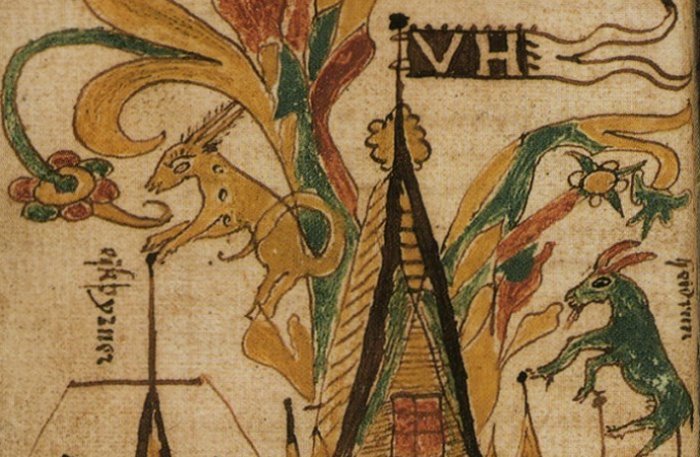A. Sutherland - AncientPages.com - Many fascinating, mythical animals dwell in and around the sacred tree Yggdrasil. We know the squirrel Ratatoskr, that is plotting intrigue and spreading gossips, and the Nidhogg (Nídhöggr), a dreadful winged corpse-eating dragon that hates Asgard and Yggdrasil.
The stag Eikþyrnir and the goat Heiðrún on top of Valhalla. Icelandic manuscript 17th century. Image credit:Árni Magnússon Institute, Iceland via Wikipedia
Both inhabitants of Asgard, Eikthyrnir (“Oak Thorny”), a magical male deer (stag), and she-goat Heidrun are two other creatures involved in life of Valhalla, Asgard, and the sacred ash, Yggdrasil.
These two are often depicted together on medieval engravings showing the entrance to Valhalla.
Laeradr Tree And What Do A Stag And She-Goat Do On Its Top?
In myths and legends, Eikthyrnir and Heidrun are described as standing atop Valhalla and consuming the leaves of evergreen Yggdrasil’s highest branch – Laerad (Laeradr).
Eikthyrnir appears in Grímnismál, (or "Song of Grimnir"), included in the “Poetic Edda”, the oldest work of the oldest monument of Icelandic writings. In "Song of Grimnir" an image of the origin of the universe was created: the magical ash of Yggdrasil, a description of the animals inhabiting it, and details of the creation of the world from the body of the giant Ymir.
In Snorri's 'Grimnismal' we read that Eikthyrnir is a source of waters:
"Eikthyrnir is the hart’s name
who stands of Father of Hosts’ hall
and grazes Lærad’s branches;
and from his horns liquid drips into Hvergelmir,
from thence all waters have their flowing...."
Eikthyrnir, draws its strength from Yggdrasil, the source of all life and the abode of mythical nine Norse worlds. As recorded in the “Gylfaginning” of the Prose Edda by Snorri Sturluson, and attested in the 13th century Poetic Edda, a mysterious fluid (water) dropped from his antlers, falls down into Hvergelmir (in Old Norse: “bubbling boiling spring").
Heidrun eats the leaves of Læraðr atop Valhalla in an illustration from an 18th-century Icelandic manuscript (the Arni Magnusson Institute in Iceland). Image credit: Wikipedia
Hvergelmir is the source of ‘Elivagar - eleven rivers: they are cool Svol and Gunnthra the defiant, Fjorm and bubbling Fimbulthul, fearsome Slid and storming Hrid, Sylg, Ylg, broad Vid and Leipt which streaks like lightning, and freezing Gjoll, according to Norse beliefs.
The well - inhabited by many snakes and the dragon Nidhogg - is located in Niflheim which is the most inhospitable world of densest mists and fogs. Two other wells are: Urðarbrunnr that lies beneath the Yggdrasil and is associated with a trio of Norns, and Mímisbrunnr, located close to the home of frost giants, Jötunheimr.
She-Goat Heidrun Delivers Heavenly Mead To Gods And Warriors
The she-goat Heidrun, stands on the roof of Valhalla cropping the branches of a tree called Laerad, often identified with Yggdrasil.
In Snorri Sturluson's Gylfaginning (Prose Edda) we read:
“The she-goat, she who is called Heidrún, stands up in Valhall and bites the needles from the limb of that tree which is very famous, and is called [Léraðr]; and from her udders mead runs so copiously, that she fills a tun every day…”
Heidrun produces a never-ending supply of magnificent mead that nourishes the gods and the fallen heroes who fight every day in Valhalla. (‘Gylfaginning’).
The mead fills a great drinking crock in the hall, enough of it to even make all the heroes drunken but the fallen warriors are also fed on the best meat that comes from the magical creature, Saehrimnir. In Norse mythology, Sæhrímnir is a boar killed and eaten every night. After Sæhrímnir is eaten, the beast is brought back to life again to provide nutrition for the following day in Valhalla.
According to Snorri Sturluson in ‘Gylfaginning’, food is not a problem because there will never be so many people in Valhalla that the meat of Sæhrímnir cannot sufficiently feed them.
Thus, the warriors never lack food for the next day of life in paradise.
Written by – A. Sutherland - AncientPages.com Senior Staff Writer
Copyright © AncientPages.com All rights reserved. This material may not be published, broadcast, rewritten or redistributed in whole or part without the express written permission of AncientPages.com
Expand for referencesReferences:
Lindow, John (2001). Norse Mythology
Brink Nicholas E. Baldr's Magic
